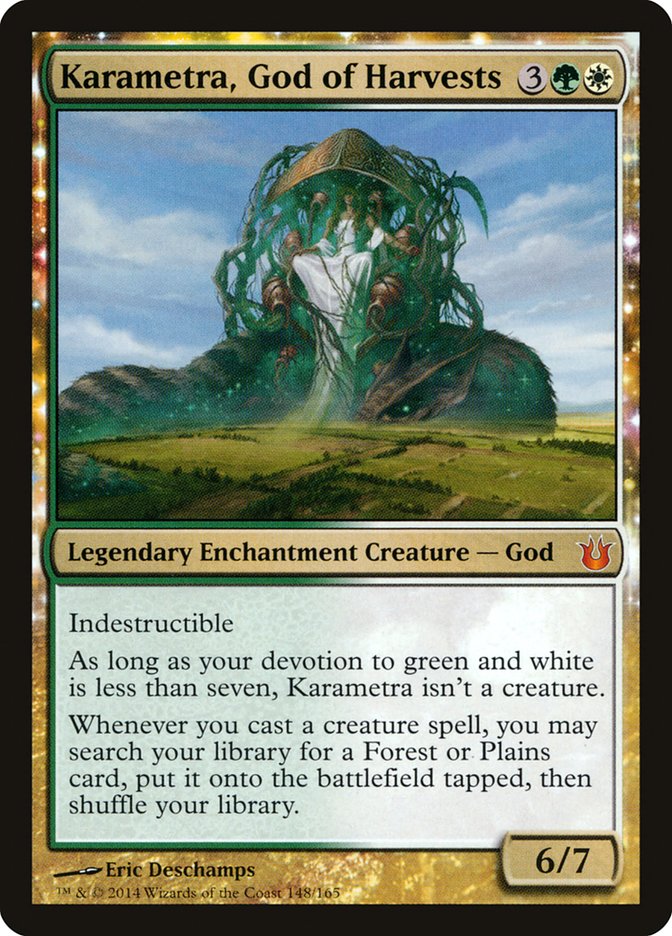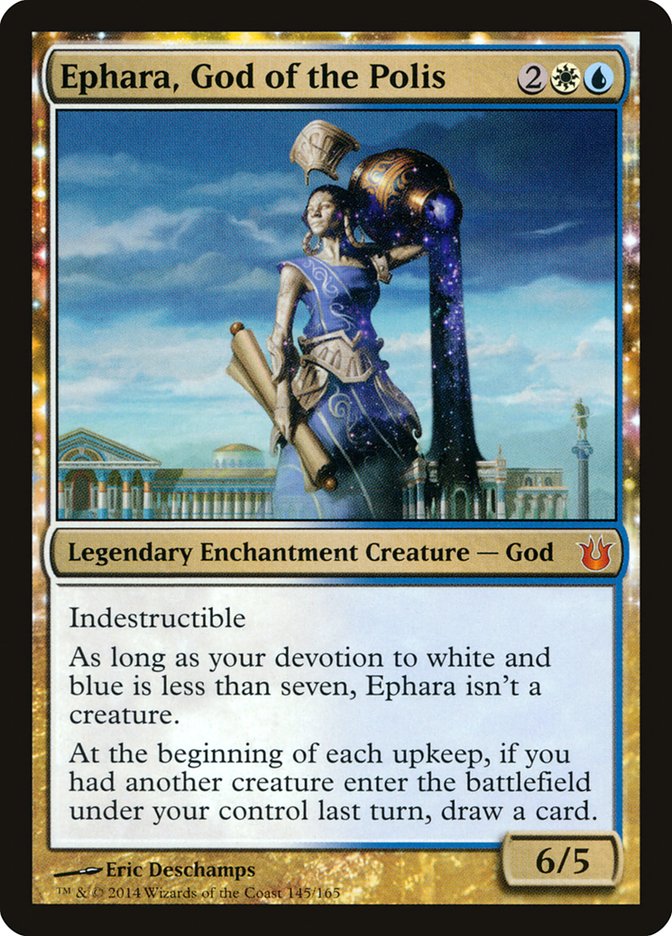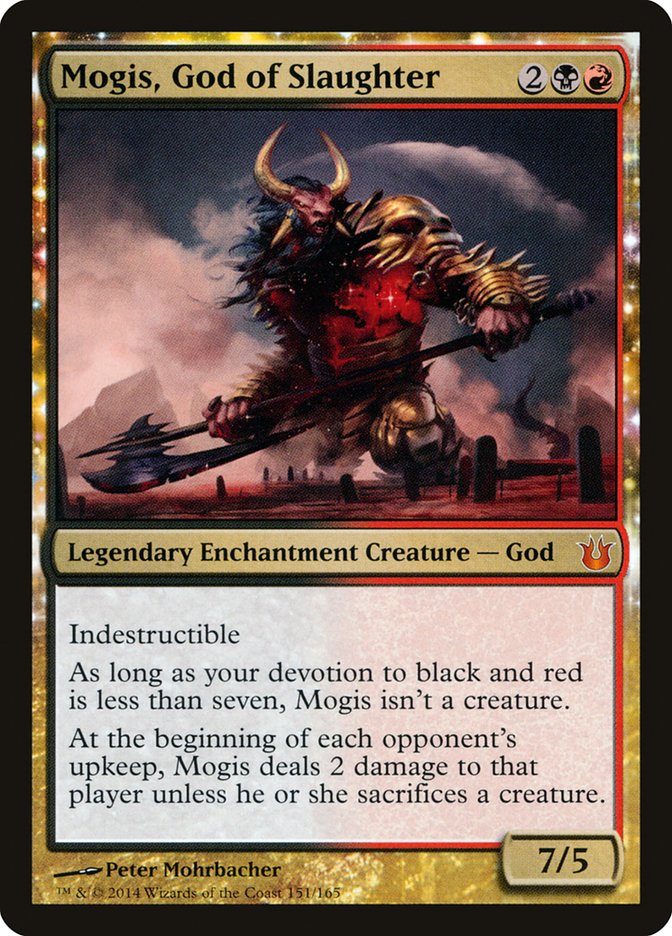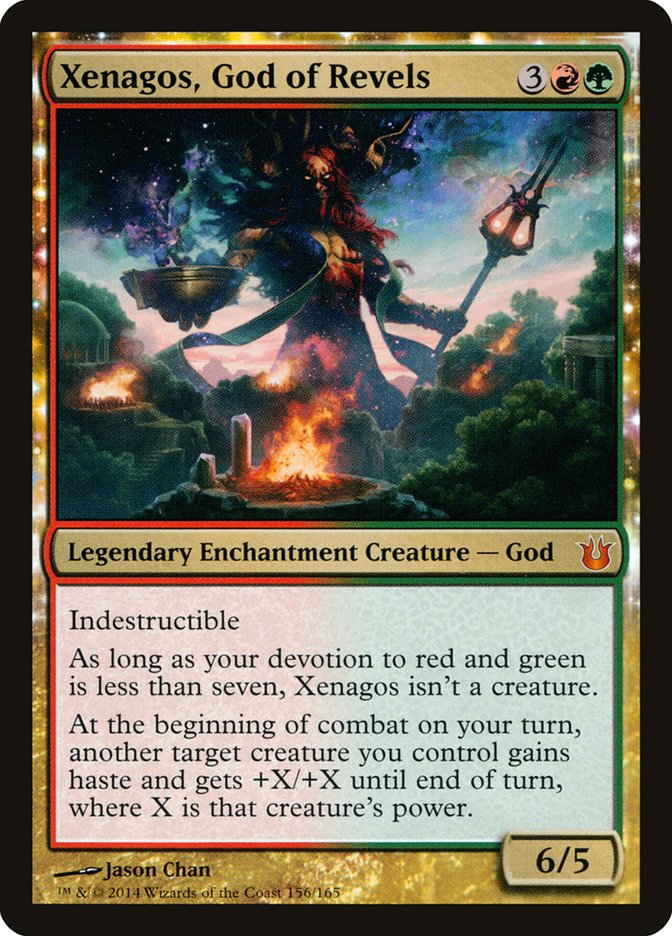Now that we’ve had a season to play with the Theros Gods, this next set should be easier to evaluate. Thassa has proven unsurprisingly to be the best of them, making a strong case for casting cost as the most significant distinction between the Gods. Three of the new Gods cost more mana than any of the Theros Gods, so we have to wonder if they’ll stack up and how we might be able to use them.
For the most part, I’m not terribly concerned with their power and toughness. Bigger is better obviously, but I think of all of the Gods as "sometimes you have a big indestructible creature" and it doesn’t really matter how big it is at that point—it blocks any one creature and usually kills it and lives, it attacks for enough damage to kill an opponent pretty quickly, and they can generally chump block with one creature. On some boards the exact size will matter, but in most games it won’t.
This means that when you pay more mana for a God what you’re really paying for is the text box. This is particularly clear when comparing Ephara, God of the Polis to Karametra, God of Harvests for example. Karametra costs an extra mana and has two extra toughness. How often do you expect that extra toughness to come up on an indestructible sometimes creature? I’d say less than one in twenty games. Much less.
Continuing with those two, I’d say the advantages of Karametra are that it’s in the color with ramp, that green is more likely to want a lot of permanents than blue, and most importantly that the ability is probably more abusable but likely less generically powerful. What I mean by that is that any deck would love to draw more cards but not all decks can really take advantage of extra lands untapping after casting a five-mana spell.
On the other hand, Ephara can only draw you a card per turn (usually one card per each of your turns, but if you work a little, sometimes you can get an extra card by making a creature on your opponent’s turn), but Karametra is relatively unbound in the number of times you can trigger it. Granted, it’s not easy to keep casting creature spells—it’s easier to keep making one token every turn (incidentally, Heliod, God of the Sun potentially pairs well with Ephara, God of the Polis)—but there are ways to do it.
The trick with Karametra is finding something to do with all that mana. My first instinct is to use it in a Bant ramp deck for card drawing to spend all that mana. Maybe something like:
Creatures (23)
- 2 Archaeomancer
- 4 Axebane Guardian
- 4 Gatecreeper Vine
- 1 Angel of Serenity
- 1 Polukranos, World Eater
- 4 Sylvan Caryatid
- 1 Prophet of Kruphix
- 1 Nylea's Disciple
- 1 Ephara, God of the Polis
- 2 Kiora's Follower
- 2 Karametra, God of Harvests
Planeswalkers (4)
Lands (23)
Spells (10)

This is a very rough list that’s designed to show a lot of possibilities and interactions. Axebane Guardian provides a lot of mana with twelve defenders in the deck, and Kiora’s Follower can untap it to go even bigger. Gatecreeper Vine offers relatively painless devotion, an extra defender, and an extra creature to trigger all the big enchantments. It also gives the deck more access to its untapped lands to smooth its mana development.
Whelming Wave buys time and resets Gatecreeper Vine; Archaeomancer; Nylea’s Disciple; Polukranos, World Eater; and if you’re going really big Angel of Serenity. These creatures can all use their abilities again as well as triggering Karametra again, and all the extra lands will let you recast them while your opponent might struggle to recast their creatures. Ideally you can loop Whelming Wave with Archaeomancer, and in the extremely late game you live the dream of looping two Archaeomancers with Whelming Wave and Fog—this costs thirteen mana every turn and turns off your mana creatures, but Karametra can get you a lot of mana.
Both Gods in this deck are intended to function primarily as enchantments, but they can turn on eventually as additional threats.
Prophet of Kruphix is excellent with all this card draw, especially Sphinx’s Revelation, and also makes it easy to get extra triggers out of Ephara.
Primeval Bounty is incredible with basically everything in this deck, but the life gain with Karametra should be noted specifically.
This deck goes big. Really, really big. While it might be too slow for the most competitive Standard tournaments, I imagine the shell should be extremely fun for less competitive FNMs and especially for multiplayer games.
I mentioned earlier that Ephara, God of the Polis plays well with Heliod, God of the Sun. They’re both interested in white permanents, and Heliod’s ability triggers Ephara’s ability. The only problem is that when you’re drawing extra cards you might not be looking for a mana sink as clunky as Heliod’s, but if your curve is low and the game is long, you easily could be.
Maybe something like:
Creatures (29)
- 1 Lyev Skyknight
- 4 Judge's Familiar
- 4 Precinct Captain
- 4 Frostburn Weird
- 1 Deputy of Acquittals
- 1 Heliod, God of the Sun
- 4 Master of Waves
- 4 Soldier of the Pantheon
- 2 Ephara, God of the Polis
- 4 Brimaz, King of Oreskos
Lands (24)
Spells (7)
Sideboard

The most exciting interaction in this deck is Spear of Heliod + Master of Waves, which allows you to keep the tokens even if Master of Waves is killed. The mana and split devotion requirements were a bit tricky, but I think using Sacred Foundry and Frostburn Weird is a reasonable solution to the problem of trying to play Spear of Heliod with both Brimaz, King of Oreskos and Master of Waves. All of the cards I’m playing one of are a little questionable—I suspect a better card could be found to play as a four-of over all of them—but they show some possibilities and serve as a placeholder until more cards are known.
I really wanted to take advantage of Vanguard of Brimaz and Phalanx Leader with Spear of Heliod and Master of Waves, but there wasn’t room for cards to trigger heroic in the shell above. I think there’s a heroic deck there, but it’s likely different than the devotion deck.
The next five-mana god in question is Phenax, God of Deception. With Phenax, I think it’s really clear that you’re paying for the ability and the body’s an afterthought. I wouldn’t even care about turning on the body except that it happens incidentally because you’re trying to have creatures in play to mill the opponent with and then Phenax becomes an extra mill seven, which is not small. Historically, this kind of card has been much better in Limited where you only have to mill 40-card decks than in Constructed where you have to mill an additional twenty, and I don’t see this as an exception. This card looks absolutely absurd in Limited but likely slow for Constructed. I will note that it’s really cute with Wight of Precinct Six however.
Another option is to us Duskmantle Guildmage to kill them with damage by milling them to speed things along a little, but it’s a little weak for Constructed. I’d worry about getting run over.
Ashiok, Nightmare Weaver obviously fits well here as an additional way to get the milling started, a source of devotion, and most importantly an on-color planeswalker in a deck that’s trying to play creatures that it wants to block with anyway.
The big question is what those creatures are, and aside from Wight of Precinct Six and maybe Cloudfin Raptor, nothing’s really jumping out at me. Nightveil Specter is fairly obvious, and I suppose Desecration Demon mills for a lot and kind of skirts the drawback (but only kind of in that you still can’t try to block with it and mill them if they tap it). I suppose a deck with those cards would look something like:
4 Cloudfin Raptor
4 Frostburn Weird
4 Wight of Precinct Six
4 Nightveil Specter
4 Master of Waves
4 Desecration Demon
2 Ashiok, Nightmare Weaver
2 Phenax, God of Deception
3 Psychic Strike
4 Bile Blight
1 Devour Flesh
4 Watery Grave
4 Blood Crypt
4 Temple of Deception
4 Dimir Guildgate
4 Island
4 Swamp
Sideboard
3 Gainsay
4 Thoughtseize
2 Dark Betrayal
2 Doom Blade
2 Underworld Connections
2 Drown in Sorrow
While I love Wight of Precinct Six, I suspect that the mill theme isn’t really strong or fast enough here to really support it and that this deck is just weaker than one that isn’t try to use Phenax. I could be wrong, but my suspicion is that this card will be obnoxiously powerful in Limited and won’t see play in Constructed.
Continuing around the color wheel brings us to Mogis, God of Slaughter. To start with, this is kind of like a two-power indestructible creature with haste and deathtouch if you ignore the ability for it to become a creature. Every turn they have to chump block it or take two. That’s not bad but certainly isn’t good enough for four mana on its own. We’re going to need to turn this creature on.
However, if we can do that, we get a seven-power creature for four that kind of attacks for nine and can’t all be blocked at once. That’s a pretty good rate.
The best part is that Mogis has both Burning-Tree Emissary and potentially Ragemonger to help get a lot of devotion without spending all the mana one would normally have to get it.
Ragemonger plays so well with Mogis, God of Slaughter that I’d definitely want to start by trying to build a Minotaur deck. Maybe something like:
Creatures (35)
- 4 Burning-Tree Emissary
- 4 Firefist Striker
- 4 Boros Reckoner
- 4 Rageblood Shaman
- 4 Kragma Warcaller
- 4 Fanatic of Mogis
- 4 Deathbellow Raider
- 3 Mogis, God of Slaughter
- 4 Ragemonger
Lands (25)
Sideboard

The plan with this deck is to play a tapped land on turn 1 every game since there are no one-mana Minotaurs and off-type creatures are so much worse with this many lords. There aren’t enough cheap Minotaurs to allow the deck to play only Minotaurs, and I chose to use the other early creatures to take advantage of Burning-Tree Emissary, which is important with devotion from Mogis, God of Slaughter and Fanatic of Mogis.
If this deck gets another 1R Minotaur to replace Firefist Striker, it would really like to do that. This is untuned, but I wouldn’t be at all surprised to see Minotaurs as a successful tribal archetype in the coming months.
The last God is Xenagos, God of Revels, and this is another five-mana god where it’s clear that we’re really paying for the text box and getting the body as an added bonus. Fortunately, the text box looks like something I would expect to see on a five-mana enchantment, although I wouldn’t expect that enchantment to see play in Constructed.
Xenagos is the perfect colors to take advantage of green ramp and Burning-Tree Emissary’s devotion boost and smoothly slots somewhere into the existing G/R Devotion paradigm.
I’m torn on whether it’s what I want to be doing with my mana when I ramp with one of those decks. The biggest strike against it is that Stormbreath Dragon, one of the better things I could be ramping into, already has haste. The four extra damage is nice, but I could have gotten the same thing by attacking with it a turn earlier if I’d played it instead of Xenagos.
On the other hand, Xenagos is great at going long against decks with a lot of removal, especially if they have a lot of sorcery-speed removal since all your creatures essentially get to hit them twice before they can play a sorcery to deal with them.
If your opponent doesn’t have a lot of removal, it’s more likely that Xenagos will be a creature, where it’s obviously offering a lot more than just the enchantment. I guess in practice this is likely competing with Arbor Colossus for the five-mana slot in a green devotion deck, where it has the drawback that it’s not providing anywhere near as much relevant devotion but that’s mitigated somewhat by the fact that you don’t necessarily need more devotion as much once you’re already casting your five-mana spells. I suspect it’s worth shaving an Arbor Colossus or Garruk, Caller of Beasts for a Xenagos, God of Revels or two, but I don’t think you want to go crazy with them.
Such a deck would look something like:
Creatures (28)
- 2 Scavenging Ooze
- 4 Burning-Tree Emissary
- 4 Elvish Mystic
- 4 Polukranos, World Eater
- 2 Nylea, God of the Hunt
- 4 Sylvan Caryatid
- 2 Arbor Colossus
- 4 Voyaging Satyr
- 2 Xenagos, God of Revels
Planeswalkers (9)
Lands (23)

Fanatic of Xenagos is a good card, but it just doesn’t play well enough with Nykthos for a deck like this to want it. I think Fanatic of Xenagos is most likely to see play if some kind of Jund Aggro deck emerges in this format.
My conclusion? None of these Gods are in the same league as Thassa, God of the Sea, but some of them might see play. Most of them felt like they were among the weaker cards in the decks here, and I don’t see any of them as cards to play four of. But I think Mogis, God of Slaughter is probably pretty good, and Xenagos, Ephara, and Karametra all have reasonable chances of finding a home.






